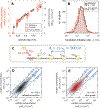Principles of gene regulation quantitatively connect DNA to RNA and proteins in bacteria
- PMID: 36480614
- PMCID: PMC9804519
- DOI: 10.1126/science.abk2066
Principles of gene regulation quantitatively connect DNA to RNA and proteins in bacteria
Abstract
Protein concentrations are set by a complex interplay between gene-specific regulatory processes and systemic factors, including cell volume and shared gene expression machineries. Elucidating this interplay is crucial for discerning and designing gene regulatory systems. We quantitatively characterized gene-specific and systemic factors that affect transcription and translation genome-wide for Escherichia coli across many conditions. The results revealed two design principles that make regulation of gene expression insulated from concentrations of shared machineries: RNA polymerase activity is fine-tuned to match translational output, and translational characteristics are similar across most messenger RNAs (mRNAs). Consequently, in bacteria, protein concentration is set primarily at the promoter level. A simple mathematical formula relates promoter activities and protein concentrations across growth conditions, enabling quantitative inference of gene regulation from omics data.
Conflict of interest statement
COMPETING INTERESTS
The authors declare no competing interests.
Figures






References
-
- Goldberg AL, St John AC, Intracellular protein degradation in mammalian and bacterial cells: Part 2. Annu. Rev. Biochem. 45, 747–803 (1976). - PubMed
-
- Nath K, Koch AL, Protein degradation in Escherichia coli. II. Strain differences in the degradation of protein and nucleic acid resulting from starvation. J. Biol. Chem. 246, 6956–6967 (1971). - PubMed
-
- Paulsson J, Models of stochastic gene expression. Phys. Life Rev. 2, 157–175 (2005).
MeSH terms
Substances
Grants and funding
LinkOut - more resources
Full Text Sources
Other Literature Sources
Molecular Biology Databases

